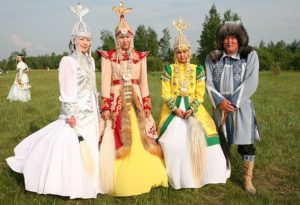National clothing is formed under the influence of several factors. Climate, life, faith and other life nuances are important. Yakut costume is designed for cold climates. Some elements of national clothing were taken from other peoples, but this does not make the costume lose its originality.
Historical reference
Yakuts live in Yakutia and the Krasnodar region. Small national communities live in the Amur region. The Yakuts also live on the territory of Magadan and Sakhalin.
 The first national costume appeared in the 18th century. It consisted of outerwear with natural fur and some decorative elements (embroidery, metal parts). Then coarse fabrics, furs, leather, silk were used.
The first national costume appeared in the 18th century. It consisted of outerwear with natural fur and some decorative elements (embroidery, metal parts). Then coarse fabrics, furs, leather, silk were used.
The Yakuts were mainly engaged in cattle breeding, so they used natural leather, suede and furs for their wardrobe.Usually they “exploited” short-haired animals, but the fur of long-haired animals was also used for insulation.
Important! Long-haired fur was used for decorative purposes, decorating the collar, cuffs, and the general perimeter of the outfit.
Features of styles
The national cut of the Yakut dress is a straight silhouette with similar sleeves. But there are several options for making the costume. Yakut clothing items:
 onoolokh, buuktaakh - the cut is borrowed from the military, characterized by folds on the back and an unusual sleeve shape;
onoolokh, buuktaakh - the cut is borrowed from the military, characterized by folds on the back and an unusual sleeve shape;- kytyylaakh is similar to the first style, differs by a strip of cloth that runs along the edges of the outerwear;
- tanalai - a winter jacket, decorated with the fur of fur-bearing animals, has a fur shoulder pad, slits on the sides.
Each style is characterized by bright decorations. Thus, the tanalai was decorated with a metal pendant, which was placed on the belt. For the cut of kytyylaakh in women's attire, red color in embroidery dominated. The men's suit was treated with duller shades.
What does a woman's suit consist of?
Women's and men's suits had the same cut. They differed only in decorative trim. A Yakut woman's wardrobe must include annakh. It was a piece of fabric that ladies used to cover their faces. Materials for women's outfits:
 everyday clothes were made from durable fabrics such as satin and chintz, because the outfit should be comfortable;
everyday clothes were made from durable fabrics such as satin and chintz, because the outfit should be comfortable;- festive attire was made from expensive bright materials - silk, satin;
- The outer outfit must warm, so fur and suede were used for it, decorative elements and silk were added for beauty.
The women's wardrobe included a coarse shirt, leather trousers (an element that protected the pelvic region), leggings, a fur coat, a hat and a large amount of jewelry.Leggings are leather leg warmers without a foot. The traditional Yakut hat resembled a helmet (as in the photo). Jewelry was of the greatest value. Women richly decorated all parts of the outfit. Beaded trim is still popular.
Men's suit: details
 The men's attire was modest when compared with the women's. Everyday clothing was trimmed with fur on the cuffs and collar. The finishing was quite voluminous. The headdress had to be practical, covering the ears from the cold. The hat resembled a helmet. You can often see ears on national hats, which are associated with cosmic communications.
The men's attire was modest when compared with the women's. Everyday clothing was trimmed with fur on the cuffs and collar. The finishing was quite voluminous. The headdress had to be practical, covering the ears from the cold. The hat resembled a helmet. You can often see ears on national hats, which are associated with cosmic communications.
Children's suits
Children's clothing is a mini copy of adult outfits. The same materials and fabrics are used to make it: hide, fur, rich decor, beadwork. The headdress is trimmed with fur.
Modern Yakut costume
 A modern suit is made from different materials. Light fabrics such as chiffon, silk, and satin are actively used. Organza, brocade, and suede are popular. Clothes must include natural fur and rich decor.. The outfit is decorated with beads, metal elements, and bright rhinestones.
A modern suit is made from different materials. Light fabrics such as chiffon, silk, and satin are actively used. Organza, brocade, and suede are popular. Clothes must include natural fur and rich decor.. The outfit is decorated with beads, metal elements, and bright rhinestones.
In the modern world there are many technologies that help reinterpret national attire. Luxurious decoration looks fabulous, as interesting styles and a bright palette of colors are used. It looks stylish, but has no historical background.
Important! When creating costumes, designers focus on fairy-tale characters, so the clothes are not historically accurate.
National costumes are worn for holidays, ceremonies, and rituals. Some elements are combined with modern outfits.Natural furs and beadwork are actively used.


 onoolokh, buuktaakh - the cut is borrowed from the military, characterized by folds on the back and an unusual sleeve shape;
onoolokh, buuktaakh - the cut is borrowed from the military, characterized by folds on the back and an unusual sleeve shape; everyday clothes were made from durable fabrics such as satin and chintz, because the outfit should be comfortable;
everyday clothes were made from durable fabrics such as satin and chintz, because the outfit should be comfortable; 0
0


_7-220x175.jpg)


